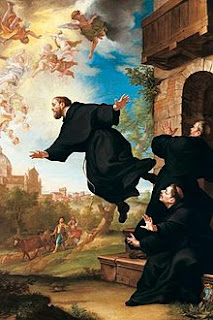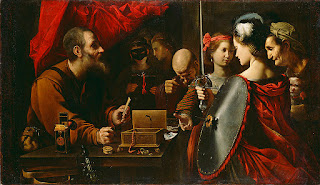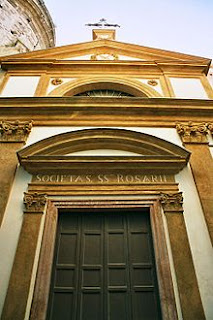Flying friar now protects aviators
 |
| Painter Ludovico Mazzanti's 18th century depiction of Saint Joseph levitating |
Joseph was canonised in 1767, more than 100 years after his death, by Pope Clement XIII and he is now the patron saint for astronauts and aviation.
Joseph’s father, Felice Desa, had died before his birth leaving large debts. After the family home was seized to settle what was owed, his mother, Francesca Panara, was forced to give birth to him in a stable.
Joseph experienced ecstatic visions as a child at school. When he was scorned by other children he had outbursts of anger.
He was apprenticed to a shoemaker but when he applied to join the Franciscan friars he was rejected because of his lack of education.
He was accepted in 1620 as a lay brother by the Capuchin friars only to be dismissed because his constant ecstasies made him unfit to carry out his required duties.
Forced to return home he pleaded with the Franciscan friars near Copertino to be allowed to work in their stables. After several years he was admitted to the Order and he was ordained a priest in 1628.
| The Basilica of San Giuseppe da Copertino in Piazza Gallo was dedicated to St Joseph |
Joseph was denounced to the Inquisition because flying and levitation were then considered to be a type of witchcraft.
On the Inquisition’s orders, he was transferred from one friary to another to be kept under observation. He lived under a strict regime, eating solid food only twice a week.
In 1657 he was at last allowed to return to live in a religious community and was sent to a friary in Osimo in Le Marche, then part of the Papal States, where he died six years later at the age of 60.
Joseph was beatified in 1753 and made a Saint in 1767.
People sceptical about the reports of Saint Joseph’s levitating or seeming to become airborne have suggested he was either a very agile man who leapt into the air or was perhaps suffering convulsions as a result of consuming bread made from infected grain, which was common centuries ago.
Nevertheless, many pilgrims now visit Joseph’s tomb to pay their respects at the Basilica of Saint Joseph of Copertino in Piazza Gallo in Osimo.
 |
| Copertino Castle, built in 1540, has tapered ramparts in each of its four corners |
Copertino, where Saint Joseph was born, is a town in the province of Lecce in the Puglia region of south east Italy. Red and rosé DOC wines are made in the area around the town. Copertino Castle, built in 1540 on the site of an older fortress, is one of the biggest fortifications in the entire region. It has a distinctive design, built on a quadrangle plan with a tapered rampart at each of the four corners. There is also a sanctuary dedicated to Saint Joseph in the town.
 |
| The main square in Osimo, the town in Le Marche where Saint Joseph died in 1663 |
One of the main sights in Osimo, where Saint Joseph died, is the Basilica of San Giuseppe da Copertino, which was founded as a church dedicated to Saint Francis but was later rededicated and refurbished to house Saint Joseph’s relics. There is also a restored Romanesque-Gothic church has a portal with sculptures of the 13th century. A town of more than 35,000 inhabitants, Osimo is located approximately 15km (9 miles) south of the port city of Ancona and the Adriatic Sea.
Also on this day:
1691: The birth of painter Giovanni Paolo Panini
1952: The birth of Sergio Marchionne, businessman
1964: The birth of racing driver Rinaldo 'Dindo' Capello
Home








